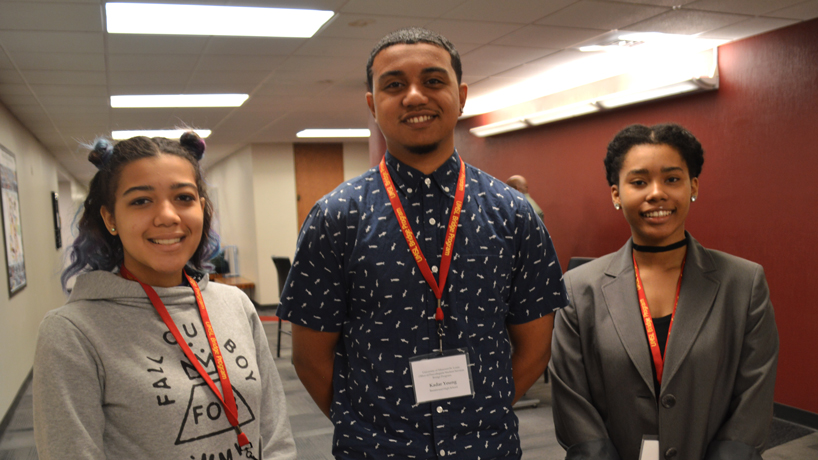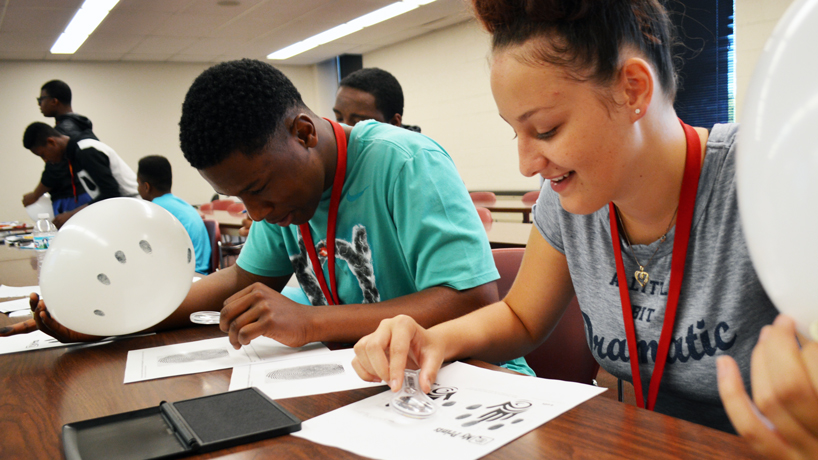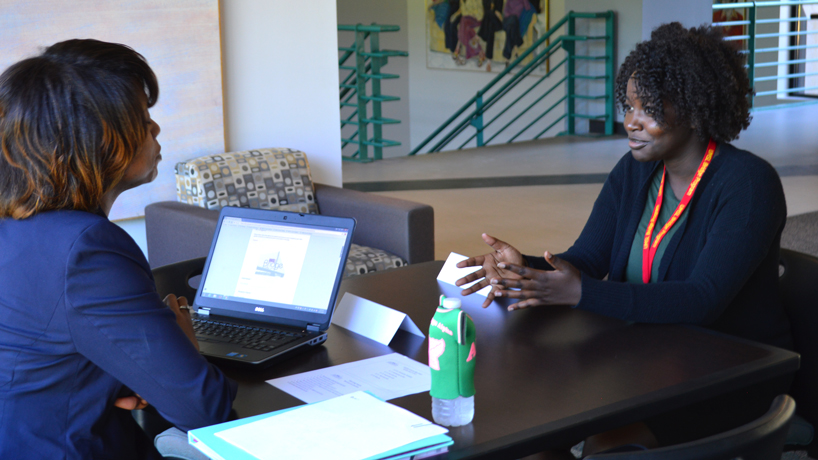
UMSL Bridge Program participants (from left) Mary Hagedorn, Kadar Young and Keren Clinton are among the more than 200 local high school students taking advantage of this year’s Summer Academy. (Photos by Evie Hemphill)
It’s early – 8:15 a.m. on a summer Tuesday – but the University of Missouri–St. Louis is already buzzing with conversation. Inside the Social Sciences & Business Building, at every turn, sit pairs of people dressed to impress.
“Tell me about a time that you had a conflict and how you resolved it,” one suited individual says to another. Their dialogue mirrors a job interview – except that this particular career seeker just turned 15.

Fingerprints are the focus one recent day as Bridge classmates Dylan Scott (at left) and Victoria Hershey each examine a set and learn to classify shapes and characteristics such as loops, whorls and ridges.
She’s one of many local high school students currently making the most of four unique weeks on UMSL’s campus, and the morning is just getting started.
“The mock interviews are part of our career and personal development component,” explains Natissia Small, director of UMSL’s precollegiate Bridge Program. “There’s a depth to the curriculum offered in Bridge that goes beyond the traditional school setting – and ultimately prepares them for what they will experience in college.”
Small, a handful of teachers and staff, and more than 200 soon-to-be high school sophomores and juniors are midway through this year’s Summer Academy, one of a number of Bridge initiatives that together serve several thousand St. Louisans each year.
Along with career preparation, this summer’s participants are exploring new topics in mathematics, science and communication, and their hard work seems to be paying off.
“It’s been really worthwhile,” says Mary Hagedorn, a student at McCluer High School, during a break. “I enjoy my math class a lot, and it’s given me a different perspective on how to do things. I like how we take things step by step and break it down in different ways.”

Grand Center Arts Academy student Tonia Williams discusses the colorful tessellation she’s working on during a Bridge math class.
That variety of approaches to teaching and learning is intentionally designed, according to Small. Now in her 10th year leading Bridge for the university, the assistant dean of students stops inside a classroom where a math lesson is underway. On every desk is a colorful, repeating, one-of-a-kind pattern known as a tessellation.
One would be forgiven for mistaking the setting for an art class, but there’s actually a lot of mathematical reflection going on as well.
“Today’s lesson provides a snapshot of how students are engaged in a project that connects mathematics to art,” Small says. “They will also learn how tessellations relate to completing an engineering project.”
Down the hallway, another group of students is talking about the essay process – prewriting, drafting, rewriting, editing and publishing – with local teacher and author Aaron Layton.
“Your first draft is not your final draft,” insists Layton, who is also the director of diversity at Westminster Christian Academy.
Every 55 minutes the participants rotate to their next session. This day’s science lesson is all about fingerprints – part of a larger section devoted to forensics.
“There are a lot of fields in science, and the hope is to demonstrate those many possibilities,” longtime Bridge instructor Robin Kyles explains. “The students really enjoyed the CSI Web Adventures the other day where they got the chance to solve three cases.”
For teachers and teens alike, the academy means an early start each day, with everyone arriving on campus by 7:45 a.m. sharp. But participants including Hagedorn say it’s been well worth sacrificing some summer snoozing.

A representative from a St. Louis corporation meets with Bridge participant Gracemary Nganga (at right). The mock interview lines up with the career and personal development course offered during the Summer Academy.
“What made me basically give up my summer weekday mornings to do this program was that I thought it was a really great opportunity to learn more about the college process and getting scholarships,” she says. “And it’s free.”
She’s learned more about UMSL, too, in the meantime.
“They have a lot of opportunities here, a lot of scholarship opportunities,” adds the Ferguson, Missouri, resident. “I definitely have a better outlook on UMSL – not that I ever had a bad one – but before I didn’t really know anything about it, and now I’ve got lots of information.”
Kadar Young, a student at Brentwood High School, has had an equally positive experience on the campus. Eager to secure funding for college, with hopes of playing basketball as well, he’s in his second year taking advantage of the Summer Academy.
“If all the instructors at UMSL are like the Bridge instructors, I can say this is a pretty friendly campus,” Young says. “They make you feel welcome and comfortable.”
For Keren Clinton, Bridge Program participation is becoming almost a family tradition.
“My older brother went to Bridge, and then my older sister, and now I’m going,” says Clinton, who is home-schooled. “It’s just kind of been a great opportunity for all of us to first experience college in high school and just learn about the career process and college application process. It’s been pretty much a must-do for all of us.”
For more information on the UMSL Bridge Program, which has been providing exemplary college access services to the St. Louis community since 1986, visit the website. Bridge is currently accepting applications for its upcoming Saturday Academy.















